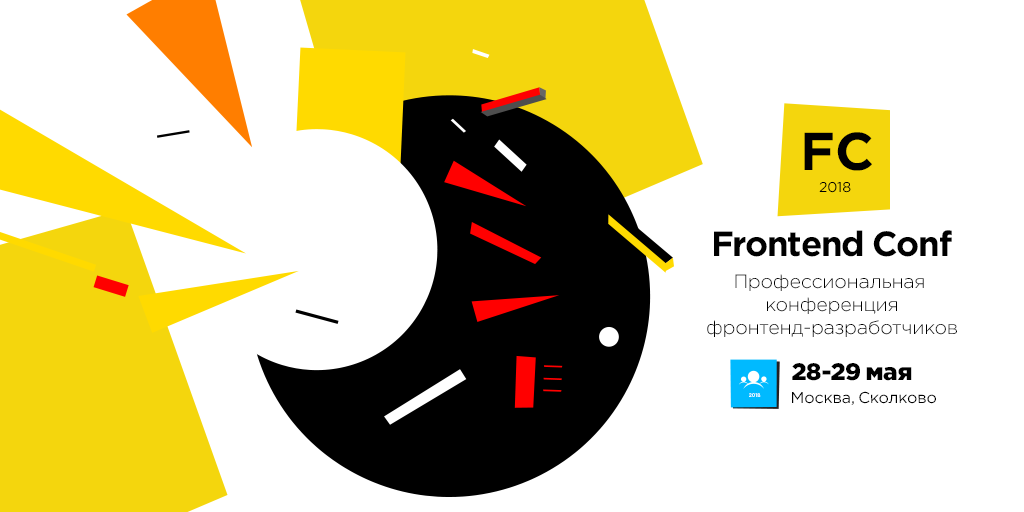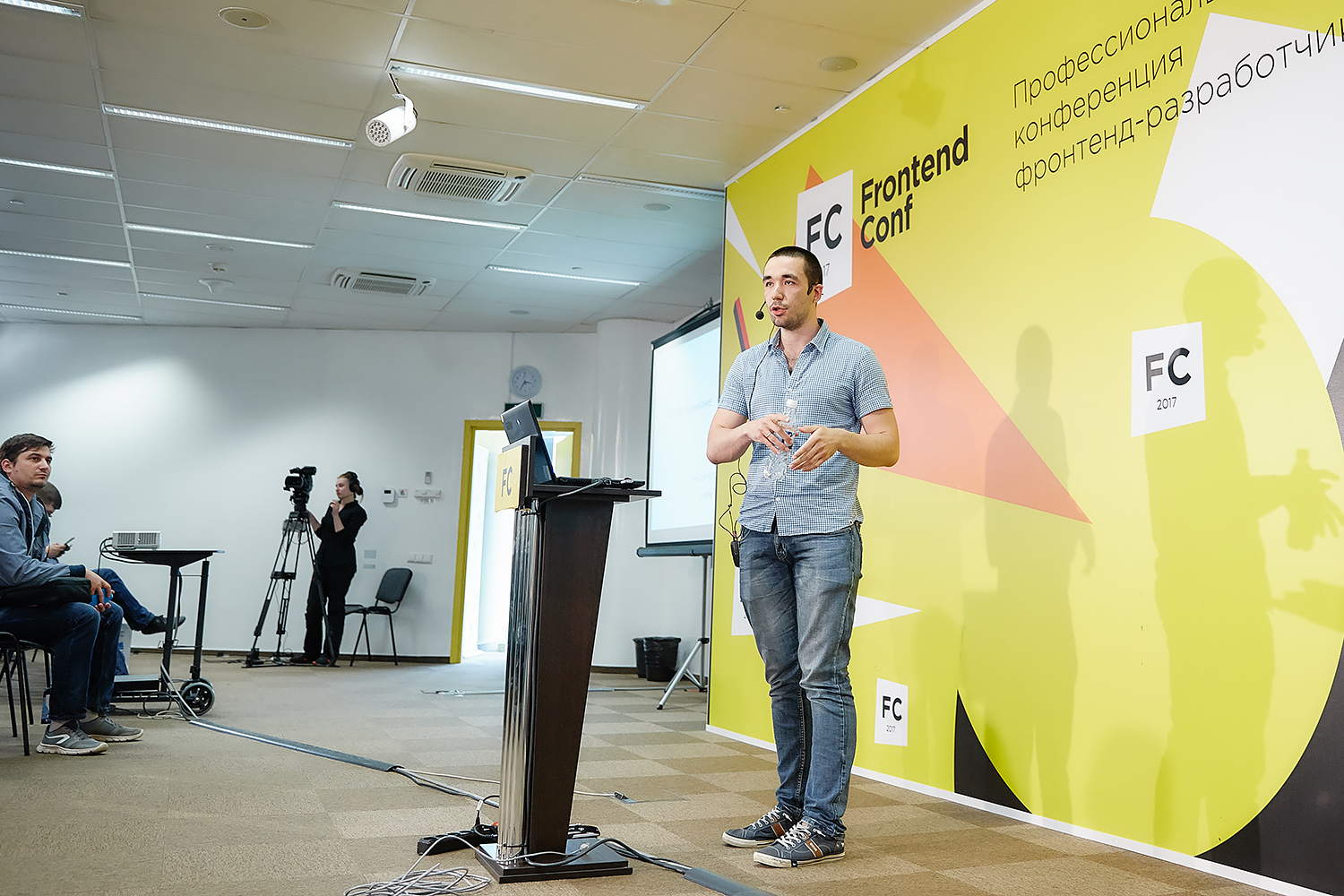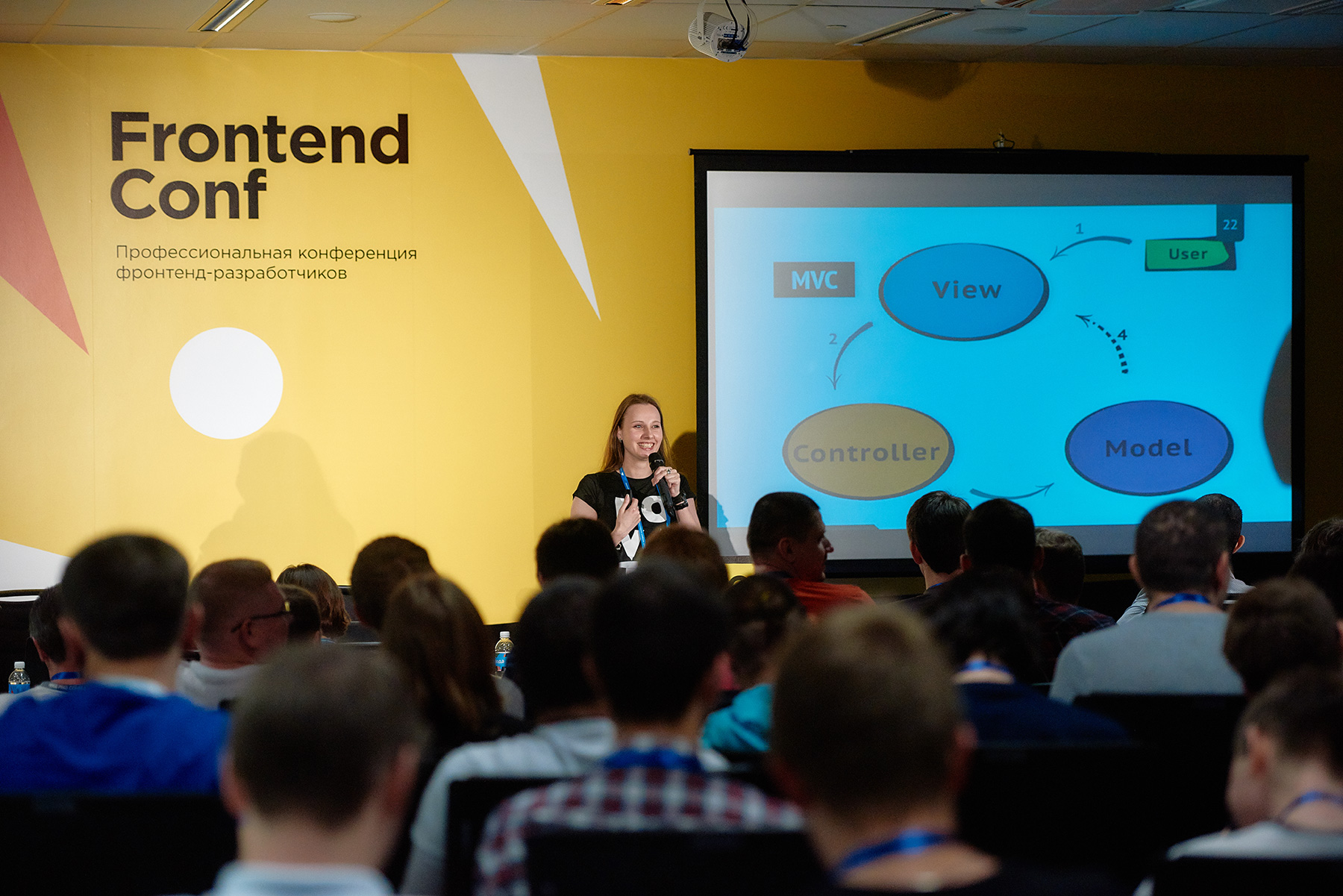The Frontend Conf program for those who do not have a flywheel of time
A third of all reports on the upcoming RHS ++ will be related to client development, which is almost 40 pieces. Naturally, they will go in two parallel specialized streams, and the most applicable for a wide audience - in the main hall. And here the flywheel of time would be useful, but it seems that instead it will have to solve a serious task of maximizing utility.
Naturally, everyone has their own criteria, so of course we will not offer you a ready-made solution. But, firstly, we are trying to form a schedule so that there is always room for maneuver, and secondly, we have prepared a brief guide on the reports.

Let's start with the speeches that will be held in the main hall, since they will be available to a wide audience of users of Habr.
')
Together with Alexei Okhrimenko from IPONWEB, we will try to determine what is wrong with the usual desire to rewrite the code, figure out how to deal with it, what approaches to refactoring are, and what they can achieve with the example of a computer game.
On the report of Timothy Lavrenyuk from KeepSolid we will analyze how to make your application more native and user- friendly with the help of modern browser capabilities. There will be examples of the use of the newest browser APIs on the real-world project, which will show how to distinguish your application from competitors .
Alexander Gutnikov from Badoo plans to talk about RUM (real user monitoring) and how he can help a modern web developer do his job better and achieve maximum application performance.
The report of Mikhail Bashurov from Luxoft will be accompanied by the mythical Ivan Tulup . Consider who this is, let's see what tasks differ from microtasks, how browsers manage task priorities and so on. All this is to use asynchronous Java Script , which has one thread, and not shoot yourself in the foot.
About the report of Egor Utrobin from Mail.ru, everything is clear - the invaluable experience of the Mail.ru mail team in implementing microservices on the frontend to speed up almost all stages of the development process. It will be interesting to know if everything is so rosy, and how much effort it took.
Let's go further. The conference is a place where you can quickly find out about trends and updates . And, immediately with analytics and rake map. That's what we will have for this part.
An active participant in the development of CSS Fonts 4, Chris Lilly , in his report will tell about the latest developments in the field of using variable fonts - a format that will fundamentally change typography . Introducing the listeners with the latest news, Chris promises to also teach “how to make beautifully” with the help of CSS.
Grigory Petrov from Voximplant promises to tell about the ideas behind WebRTC , the technology that at the end of last year became available in all major browsers and now should have killed Flash completely .
Yuri Artyukh from Coderiver will lead listeners by pixel. That is, it will share stories from real-life implementation of several animations in the browser . We explore ways to optimize animations and consider possible alternative ways to draw directly in the browser.

The category is extensive, and starting here seems logical from the story.
Anastasia Lopatina (CSSSR) proposes to give us a brief excursion on the evolution of frameworks, since this will make it possible to identify the key motive for continuous development and more consciously choose frameworks .
The Nikita Mostovogo report from HeadHunter focuses on the React-Redux stack and middleware capabilities in particular. And not about redux-thunk, redux-saga and the like, but custom ones.
Together with Andrey Solodovnikov from N1.RU, we suggest to understand the developers' fears and doubts when choosing Vue.js for a large project, and to open up the possibilities of the ecosystem of this framework.
Vitaly Glibin from Huntflow does not claim that it will be easy to explain to business why you need half a year to rewrite everything from scratch in this modern and modern framework. But he offers to share his personal experience of migrating a large and complex application from Backbone to Vue.js.
Yuri Yurin from Skyeng will talk about the process of making a common code to the library and creating a UI-kit on AngularJS . If you have a similar task, you can save more than 100 hours that have already been spent in Skyeng before you.
Zar Zakharov from Alfa-Bank will try to answer the question of whether a seamless transition between the native and the JS application is possible, for what purpose it is suitable and whether it has all the future.
Elm is not a framework , but a language that is compiled into JavaScript. But Viktor Rusakovich from GP Solutions says that you can rewrite the application to Elm in parts, leave it only in the application and get rid of AngluarJS or other frameworks.
That's not all, but with the rest you can get acquainted yourself - the list of accepted reports can be filtered by tags.

In the broadest sense of the word, this is the goal of every professional , web developers are no exception, therefore a number of reports discuss ways to improve user experience, even if a developer chooses a text editor!
Sergey Kriger from SinnerSchrader in his report plans to discuss the key principles of accessibility of interfaces, give examples and teach how to adapt the workflow so that, while working on accessibility, remain productive.
Nikita Dubko of iTechArt Group suggests trying to find the very “ideal” way of delivering images to users, at the same time automating all possible steps towards achieving this goal.
Ilya Klimov from WookieeLabs analyzed statistics collected by many developers and is ready to present obvious, non-obvious and very counterintuitive conclusions about the use of typing in the JavaScript world.
Zarema Khalilova from Uploadcare will talk about the experience of the separation of the frontend and the monolithic backend , from management to the final architecture. Let's talk about setting up the deployment, the development process and find out why everyone was happy.
Anton Kholkin will talk about the crowd source approach to removing unused CSS code and how using Booking.com minimized the negative impact on user experience (and in some cases avoided).
The report of Ivan Botanov (Domklik) about the tests, which is not surprising in this section, but not about the usual units, but about e2e . We will understand how to write them, let's talk at the same time about the BDD-approach in testing, and then we will see a small demo - an application written in Angular and tested using these tools.
Alexandra Shinkevich from LOVATA conducted a small experiment , during which she used several popular text editors, and wants to share her impressions of the work in each of them. And at the end to offer unexpected conclusions , which turned out on the basis of the experiment.

It seems that this is the time to stop. Anyway, short annotations will not reveal the topic, and only the speaker and members of the program committee know what will be in the speech itself, but they will keep the intrigue. So come, connect to the broadcast and find out everything to the smallest details - this is exactly what the couloirs are for.
See you in Skolkovo!
Naturally, everyone has their own criteria, so of course we will not offer you a ready-made solution. But, firstly, we are trying to form a schedule so that there is always room for maneuver, and secondly, we have prepared a brief guide on the reports.

main hall
Let's start with the speeches that will be held in the main hall, since they will be available to a wide audience of users of Habr.
Online broadcasts of the main hall will be able to see everyone, the link will be published on the eve of the festival in a separate news - do not miss.The report of Kamil Ismagilov from the Russian Newspaper will be devoted to the subtleties of publishing projects on GitHub. We learn how to make the OpenSource project intuitively familiar to developers and how it can be promoted.
')
Together with Alexei Okhrimenko from IPONWEB, we will try to determine what is wrong with the usual desire to rewrite the code, figure out how to deal with it, what approaches to refactoring are, and what they can achieve with the example of a computer game.
On the report of Timothy Lavrenyuk from KeepSolid we will analyze how to make your application more native and user- friendly with the help of modern browser capabilities. There will be examples of the use of the newest browser APIs on the real-world project, which will show how to distinguish your application from competitors .
Alexander Gutnikov from Badoo plans to talk about RUM (real user monitoring) and how he can help a modern web developer do his job better and achieve maximum application performance.
The report of Mikhail Bashurov from Luxoft will be accompanied by the mythical Ivan Tulup . Consider who this is, let's see what tasks differ from microtasks, how browsers manage task priorities and so on. All this is to use asynchronous Java Script , which has one thread, and not shoot yourself in the foot.
About the report of Egor Utrobin from Mail.ru, everything is clear - the invaluable experience of the Mail.ru mail team in implementing microservices on the frontend to speed up almost all stages of the development process. It will be interesting to know if everything is so rosy, and how much effort it took.
In this place, before proceeding to the sectional reports, we consider it appropriate to indicate a link to booking tickets .
New items
Let's go further. The conference is a place where you can quickly find out about trends and updates . And, immediately with analytics and rake map. That's what we will have for this part.
An active participant in the development of CSS Fonts 4, Chris Lilly , in his report will tell about the latest developments in the field of using variable fonts - a format that will fundamentally change typography . Introducing the listeners with the latest news, Chris promises to also teach “how to make beautifully” with the help of CSS.
Grigory Petrov from Voximplant promises to tell about the ideas behind WebRTC , the technology that at the end of last year became available in all major browsers and now should have killed Flash completely .
Yuri Artyukh from Coderiver will lead listeners by pixel. That is, it will share stories from real-life implementation of several animations in the browser . We explore ways to optimize animations and consider possible alternative ways to draw directly in the browser.

Javascript frameworks
The category is extensive, and starting here seems logical from the story.
Anastasia Lopatina (CSSSR) proposes to give us a brief excursion on the evolution of frameworks, since this will make it possible to identify the key motive for continuous development and more consciously choose frameworks .
The Nikita Mostovogo report from HeadHunter focuses on the React-Redux stack and middleware capabilities in particular. And not about redux-thunk, redux-saga and the like, but custom ones.
Together with Andrey Solodovnikov from N1.RU, we suggest to understand the developers' fears and doubts when choosing Vue.js for a large project, and to open up the possibilities of the ecosystem of this framework.
Vitaly Glibin from Huntflow does not claim that it will be easy to explain to business why you need half a year to rewrite everything from scratch in this modern and modern framework. But he offers to share his personal experience of migrating a large and complex application from Backbone to Vue.js.
Yuri Yurin from Skyeng will talk about the process of making a common code to the library and creating a UI-kit on AngularJS . If you have a similar task, you can save more than 100 hours that have already been spent in Skyeng before you.
Zar Zakharov from Alfa-Bank will try to answer the question of whether a seamless transition between the native and the JS application is possible, for what purpose it is suitable and whether it has all the future.
Elm is not a framework , but a language that is compiled into JavaScript. But Viktor Rusakovich from GP Solutions says that you can rewrite the application to Elm in parts, leave it only in the application and get rid of AngluarJS or other frameworks.
That's not all, but with the rest you can get acquainted yourself - the list of accepted reports can be filtered by tags.

Quality
In the broadest sense of the word, this is the goal of every professional , web developers are no exception, therefore a number of reports discuss ways to improve user experience, even if a developer chooses a text editor!
Sergey Kriger from SinnerSchrader in his report plans to discuss the key principles of accessibility of interfaces, give examples and teach how to adapt the workflow so that, while working on accessibility, remain productive.
Nikita Dubko of iTechArt Group suggests trying to find the very “ideal” way of delivering images to users, at the same time automating all possible steps towards achieving this goal.
Ilya Klimov from WookieeLabs analyzed statistics collected by many developers and is ready to present obvious, non-obvious and very counterintuitive conclusions about the use of typing in the JavaScript world.
Zarema Khalilova from Uploadcare will talk about the experience of the separation of the frontend and the monolithic backend , from management to the final architecture. Let's talk about setting up the deployment, the development process and find out why everyone was happy.
Anton Kholkin will talk about the crowd source approach to removing unused CSS code and how using Booking.com minimized the negative impact on user experience (and in some cases avoided).
The report of Ivan Botanov (Domklik) about the tests, which is not surprising in this section, but not about the usual units, but about e2e . We will understand how to write them, let's talk at the same time about the BDD-approach in testing, and then we will see a small demo - an application written in Angular and tested using these tools.
Alexandra Shinkevich from LOVATA conducted a small experiment , during which she used several popular text editors, and wants to share her impressions of the work in each of them. And at the end to offer unexpected conclusions , which turned out on the basis of the experiment.

It seems that this is the time to stop. Anyway, short annotations will not reveal the topic, and only the speaker and members of the program committee know what will be in the speech itself, but they will keep the intrigue. So come, connect to the broadcast and find out everything to the smallest details - this is exactly what the couloirs are for.
See you in Skolkovo!
Source: https://habr.com/ru/post/358360/
All Articles